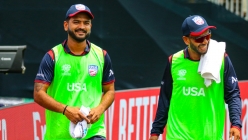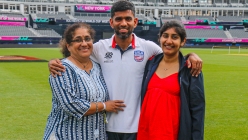Murali Vijay - Rahul Dravid of the next generation?
2009 Dec 07 by Suresh Menon
If Murali Vijay has not yet sent Gautam Gambhir's sister a thank you card, he should do so now, for it was her wedding and Gambhir's insistence on attending it that gave the Tamil Nadu opener a chance to cement a place in the Indian team. He didn't make a century that was his for the asking, and in the blinding light of Virender Sehwag's effort, all supporting acts were relegated to the shadows anyway. But more than the runs he made, it was the manner of making them that suggested - dare we say it? - he might be the Rahul Dravid of the next generation.
If Murali Vijay has not yet sent Gautam Gambhir’s sister a thank you card, he should do so now, for it was her wedding and Gambhir’s insistence on attending it that gave the Tamil Nadu opener a chance to cement a place in the Indian team. He didn’t make a century that was his for the asking, and in the blinding light of Virender Sehwag’s effort, all supporting acts were relegated to the shadows anyway. But more than the runs he made, it was the manner of making them that suggested – dare we say it? – he might be the Rahul Dravid of the next generation.
With Sehwag and Gambhir established as the opening combination for some time, Vijay will have to drop down the order in the national team, a journey in the reverse direction from the one usually taken by Indian openers.
Till the arrival of Sunil Gavaskar in 1971, opening batsmen in Indian cricket were seen as sacrificial lambs. Even the best – Vijay Merchant, Mushtaq Ali, Pankaj Roy – began as middle order batsmen who were forced to become openers. Often it was enlightened self-interest that led to the decision, many seeing in the move a chance to keep a regular place in the side by bravely offering to open.
Murali Vijay played the medium pacers comfortably, getting out of the way of the short-pitched deliveries both easily and elegantly, and when Muttiah Muralidaran came on, drove him past cover with the minimum of effort. He brought up his fifty with a six, and at no point in the 200-plus partnership with Sehwag did he look like a man playing in only his second Test. It was a confident, professional innings that was aesthetically pleasing as well, and that is a combination of virtues few young Indian batsmen bring to their efforts.
India are on the verge of a generational change in their batting line-up. Sourav Ganguly has retired, and it is possible that the Tendulkar-Dravid-Laxman combination has played its last Test at home. Gambhir himself has been a worthy replacement, and if Vijay lives up to the promise he has shown so far, then the blow at the rapid retirements will be considerably reduced. India, spoilt by the exploits by their fabulous middle order, will settle for nothing less than high scores made consistently over a long period.
In Mumbai, Vijay suggested that he had the technique and the toughness. It takes remarkable self-belief to continue batting in your own individual style while a Sehwag is tearing the bowling apart at the other end. Even granting that Sehwag might have softened the bowling for Vijay, there was enough in the latter’s approach to suggest that he could be a long-term player.
On any other occasion, his batting would have been the talking point of the Indian innings. But, as Dravid has shown, being overshadowed by a multi-hued strokeplayer is part of the package for the batsman around whom an innings is expected to revolve.
‘Vijay’ is a much-revered name in Indian cricket, being the first name of three of the greatest pre-Tendulkar batsmen: Merchant, Hazare and Manjrekar. The latest Vijay has the potential to sit in that company.
Had there been a fourth Test, Vijay would have remained in the eleven even after Gambhir’s return. With six of the top seven batsmen all having made half centuries in Mumbai, the axe might have fallen on the one who didn’t – Yuvraj Singh. In that case, Yuvraj might have had to send a card to Gambhir’s sister, with an ironic twist to the ‘Thank you’ message.




